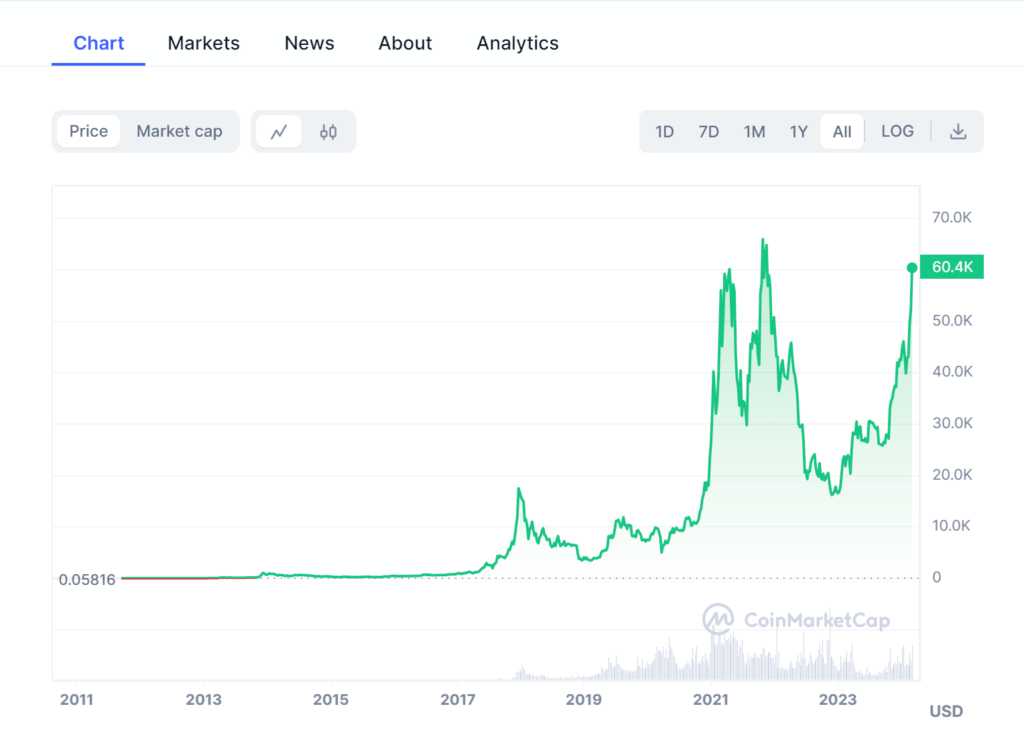Bitcoin is on the rise. The first cryptocurrency has now reached $60,000, very close to breaking its 2021 record. Could bitcoin continue its crazy rise to the very symbolic $100,000?
Certainly, bitcoin has accustomed us to roller coasters, but its movements remain no less spectacular. Barely a year ago, its price experienced a huge drop during the collapse of the FTX platform. It then plunged below $17,000. At the start of 2024, however, bitcoin experienced a lightning recovery, rising to $60,000 in record time. How far can he go?
Advertisement
From 100 to 60,000 dollars since 2013
When bitcoin crossed $100 for the first time in 2013, no one really believed in the future of this cryptocurrency. Launched in 2009 by an anonymous computer scientist calling himself Satoshi Nakamoto, bitcoin was then the playground of a few geeks passionate about blockchain and seduced by the concept of a decentralized digital currency.
Ten years (and 830,000 blocks) later, it seems to have exceeded all promises: both an exchange network, digital currency and financial asset, the longevity and success of bitcoin surprises as much as it fascinates. Because BTC has become a serious, unavoidable subject, far from the contempt it once inspired among bankers.
With a total capitalization of over $1 trillion, it ranks just behind companies like Meta or Amazon. With this enormous figure, the financial world can no longer simply ignore the phenomenon. To the point that even Wall Street traders are now taking a close interest in it.
Bitcoin boosted by BlackRock ETFs and halving
It must be said that the American giant BlackRock is launching a real digital gold rush by offering bitcoin ETFs. These synthetic financial products replicate the price of the first cryptocurrency. ETFs then allow the general public to acquire bitcoin, without having to go through exchange platforms like Binance or Coinbase. To do this, BlackRock must (in principle) buy as much equivalent bitcoin, automatically maintaining the price upwards. A sort of bitcoin on steroids, boosted by an influx of new money from traditional finance, which explains the spectacular rise that bitcoin is experiencing.
Advertisement
The surge in bitcoin can also be explained by the imminent halving, which will take place in April 2024. This halving of the reward for bitcoin miners is written into the code and occurs every 4 years. As bitcoins become rarer, they are also, in theory, more expensive. “Only” 1,312,500 bitcoins will be created between 2024 and 2028, as calculated by Satoshi Nakamoto from 2009. Investors then speculate on the rise and anticipate a lasting increase. Especially since historically, the three previous halvings have always been accompanied by an increase. Enough to forge a self-fulfilling prophecy for the future price of bitcoin.

Bitcoin at $100,000: reasons to believe in it
Now, there is an entire industry that thrives around bitcoin and cryptocurrencies in general: there is mining, but also blockchain analysis and digital wallet solutions. For some, predicting bitcoin at $100,000 is above all a question of marketing, or even survival. This is particularly the case for miners who need a rising bitcoin to cover their costs (especially if their BTC gain is halved due to halving).
But beyond the desire of industry players to see their precious bitcoins increase in value, there are serious arguments to envisage a bitcoin at $100,000 one day.
- Firstly, the general macroeconomic context could be favorable to it. Indeed, if central bank key rates fall in 2024 as some experts think, more money will be poured into the economy. And part of it will inevitably feed financial assets, such as cryptocurrencies, but also gold, stocks and even real estate. If everything goes up, then the price of bitcoin should follow as well. Logic.
- Furthermore, the rise of bitcoin is in some way written in its DNA, programmed in the code. In addition to the upcoming halving, the total BTC supply is limited to 21 million units. Thus, the Bitcoin blockchain protocol voluntarily organizes its scarcity, in accordance with Satoshi Nakamoto's vision. Consequence: there will not be (whole) bitcoins for everyone. This is why many imagine it one day competing with gold, in a digital version. An opinion shared by Marion Laboure, analyst for the Deutsche Bank who believes that “ bitcoin could become the gold of the 21st century “. Just that.
A new world ?
In the case of cryptocurrencies, bitcoin is the tree that hides the forest. By crossing the symbolic threshold of $100,000, it would strengthen the entire emerging web3 economy. Over the years, it has become the monetary standard of this new financial world, which mixes cryptos, NFTs, gaming and metaverses. In such a scenario, we can expect an increasingly significant democratization of cryptocurrencies among the general public. Which means that digital giants will have to align to integrate cryptos and NFTs into their software, applications, and interfaces.
A $100,000 bitcoin would also be far from geopolitically trivial. Globalized and easily transferable, it could attract the desire of great powers wishing to escape from the American petrodollar system, at a time when the countries of the South are seeking a new common currency. In 2021, El Salvador was the first state to adopt bitcoin as legal tender. Others could follow.
Furthermore, if bitcoin reaches six figures, network consumption will increase. The mining industry will absolutely have to turn to cheap and abundant electricity. And even if the players in the sector claim green and carbon-free energy, the reality is more nuanced. The actual consumption of the network remains poorly known, but it is currently around the 170 TWh per year. This, without taking into account the pollution generated by the production of mining machines and their difficult recycling. The rise of bitcoin could in any case benefit countries that rely on mining, such as Kazakhstan or Ethiopia.
Bitcoin at $100,000 : political and electoral consequences
Politically too, bitcoin is not neutral. It carries with it a whole series of promises linked to its cryptographic properties and its proposal for private money without trusted third parties: sovereignty, freedom, market law. Themes which echo some of those of the radical right, as Nastasia Hadjadji explains. More precisely, libertarians have made bitcoin their hobby horse. And with its rise, their ideas gain popularity.
Elon Musk himself seems close to libertarianism, this marginal school of thought which advocates the total absence of the state, replaced solely by the market. This is also the opinion of the newly elected Argentine President, Javier Milei. By saying he was open to bitcoin, he successfully used it to rally young people to his ultraliberal ideas. With bitcoin at $100,000, more and more political figures will have to take a stance on the subject.
With the American elections approaching, this will undoubtedly also be the case for Donald Trump. The Republican candidate had already launched a collection of NFTs bearing his image, sometimes depicted as a cowboy, a superhero or a construction worker. Recently interviewed by Fox News on the subject of bitcoin, the former president leaves doubt: “ Many people are adopting it. I see more and more people wanting to pay with bitcoins. I can deal with it somehow “. Opportunist, Trump? The year 2024 promises to be decidedly eventful for bitcoin and cryptocurrencies.
